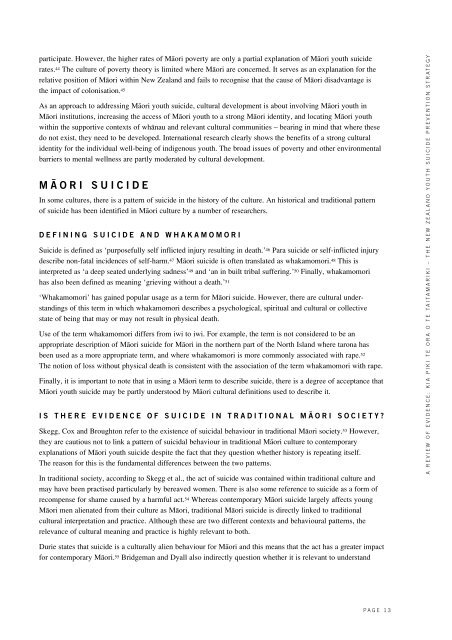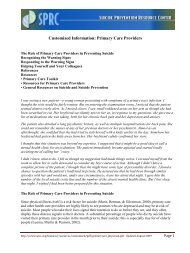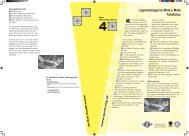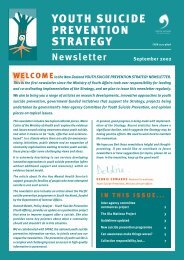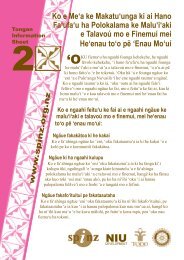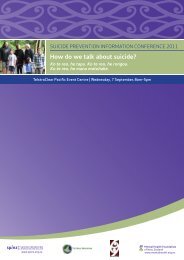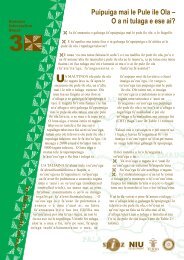A background document to support Kia Piki Te Ora O Te ... - SPINZ
A background document to support Kia Piki Te Ora O Te ... - SPINZ
A background document to support Kia Piki Te Ora O Te ... - SPINZ
You also want an ePaper? Increase the reach of your titles
YUMPU automatically turns print PDFs into web optimized ePapers that Google loves.
participate. However, the higher rates of Mäori poverty are only a partial explanation of Mäori youth suicide<br />
rates. 44 The culture of poverty theory is limited where Mäori are concerned. It serves as an explanation for the<br />
relative position of Mäori within New Zealand and fails <strong>to</strong> recognise that the cause of Mäori disadvantage is<br />
the impact of colonisation. 45<br />
As an approach <strong>to</strong> addressing Mäori youth suicide, cultural development is about involving Mäori youth in<br />
Mäori institutions, increasing the access of Mäori youth <strong>to</strong> a strong Mäori identity, and locating Mäori youth<br />
within the <strong>support</strong>ive contexts of whänau and relevant cultural communities – bearing in mind that where these<br />
do not exist, they need <strong>to</strong> be developed. International research clearly shows the benefits of a strong cultural<br />
identity for the individual well-being of indigenous youth. The broad issues of poverty and other environmental<br />
barriers <strong>to</strong> mental wellness are partly moderated by cultural development.<br />
M ĀORI SUICIDE<br />
In some cultures, there is a pattern of suicide in the his<strong>to</strong>ry of the culture. An his<strong>to</strong>rical and traditional pattern<br />
of suicide has been identified in Mäori culture by a number of researchers.<br />
DEFINING SUICIDE AND WHAKAMOMORI<br />
Suicide is defined as ‘purposefully self inflicted injury resulting in death.’ 46 Para suicide or self-inflicted injury<br />
describe non-fatal incidences of self-harm. 47 Mäori suicide is often translated as whakamomori. 48 This is<br />
interpreted as ‘a deep seated underlying sadness’ 49 and ‘an in built tribal suffering.’ 50 Finally, whakamomori<br />
has also been defined as meaning ‘grieving without a death.’ 51<br />
‘Whakamomori’ has gained popular usage as a term for Mäori suicide. However, there are cultural understandings<br />
of this term in which whakamomori describes a psychological, spiritual and cultural or collective<br />
state of being that may or may not result in physical death.<br />
Use of the term whakamomori differs from iwi <strong>to</strong> iwi. For example, the term is not considered <strong>to</strong> be an<br />
appropriate description of Mäori suicide for Mäori in the northern part of the North Island where tarona has<br />
been used as a more appropriate term, and where whakamomori is more commonly associated with rape. 52<br />
The notion of loss without physical death is consistent with the association of the term whakamomori with rape.<br />
Finally, it is important <strong>to</strong> note that in using a Mäori term <strong>to</strong> describe suicide, there is a degree of acceptance that<br />
Mäori youth suicide may be partly unders<strong>to</strong>od by Mäori cultural definitions used <strong>to</strong> describe it.<br />
IS THERE EVIDENCE OF SUICIDE IN TRADITIONAL MĀORI SOCIETY?<br />
Skegg, Cox and Brough<strong>to</strong>n refer <strong>to</strong> the existence of suicidal behaviour in traditional Mäori society. 53 However,<br />
they are cautious not <strong>to</strong> link a pattern of suicidal behaviour in traditional Mäori culture <strong>to</strong> contemporary<br />
explanations of Mäori youth suicide despite the fact that they question whether his<strong>to</strong>ry is repeating itself.<br />
The reason for this is the fundamental differences between the two patterns.<br />
In traditional society, according <strong>to</strong> Skegg et al., the act of suicide was contained within traditional culture and<br />
may have been practised particularly by bereaved women. There is also some reference <strong>to</strong> suicide as a form of<br />
recompense for shame caused by a harmful act. 54 Whereas contemporary Mäori suicide largely affects young<br />
Mäori men alienated from their culture as Mäori, traditional Mäori suicide is directly linked <strong>to</strong> traditional<br />
cultural interpretation and practice. Although these are two different contexts and behavioural patterns, the<br />
relevance of cultural meaning and practice is highly relevant <strong>to</strong> both.<br />
A REVIEW OF EVIDENCE: KIA PIKI TE ORA O TE TAITAMARIKI – THE NEW ZEALAND YOUTH SUICIDE PREVENTION STRATEGY<br />
Durie states that suicide is a culturally alien behaviour for Mäori and this means that the act has a greater impact<br />
for contemporary Mäori. 55 Bridgeman and Dyall also indirectly question whether it is relevant <strong>to</strong> understand<br />
PAGE 13


